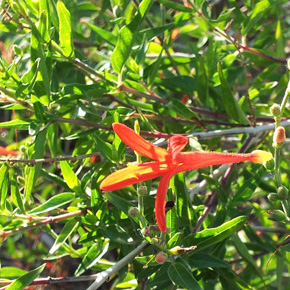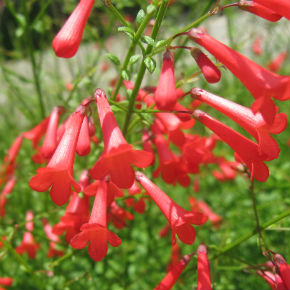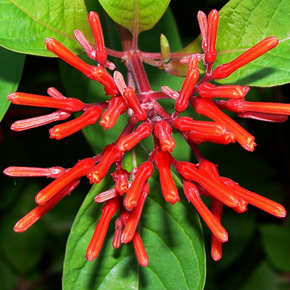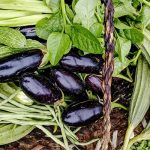Add a little spark to your landscape this Fourth of July. Firecracker plants are garden superstars with bursts of tiny red blooms that glow like red embers, even during the brightest daylight.
Although drought conditions often restrict the sale and use of firecrackers in Bexar County, there are a few options guaranteed to brighten a summer evening without setting fires.
We’re talking about firecracker plants: those garden superstars with tiny flowers but big presence, bursts of tiny red blooms, glowing like red embers even during the brightest daylight.
 |
- Flame Acanthus (Anisacanthus quadrifidus var. wrightii) grows wild at the southern edge of the Edwards Plateau, but can adapt everywhere from heavy clays to pots. Robust and drought tolerant, it’s a shrub that bursts into flower after any summer rain with orange-red blooms. It can be grown as a shrub or low hedge, but it tends to reseed freely in the garden; cut it back in late winter to keep it compact. It’s one of the drought-hardiest of all the firecracker plants.
|
 |
- The classic Gulf Coast firecracker perennial is the fernlike, many-branched Russelia equisetiformis. Names like “Coral blow” and “Coral fountains” give a good idea of the explosive appearance of this Mexican native. Yellow cultivars are available, but in my opinion the red blooms are much more visible — and you’ll notice them everywhere from hotel lobbies to hummingbird gardens, cascading softly over the edges of walkways. It’s a little more tender and less woody than acanthus, but performs very respectably under cultivation.
|
 |
- Mexican firebush tends to make other firecracker plants look like mere sparklers — this one gets big, with coffee-like textured leaves and clusters of red tube flowers. Although it typically freezes to the ground every winter, it comes back bigger and bigger each year so give it plenty of room. Although it can grow on its own, Mexican firebush generally appreciates lots of water and lots of sun.
|
Don’t worry about any of these species catching fire, the tiny “sparks” you might see jumping from bush to bush are actually hummingbirds!






